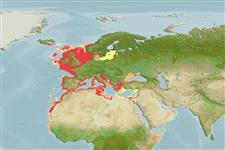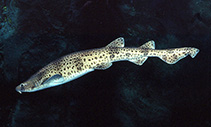Scyliorhinus stellaris (Linnaeus, 1758)
Nursehound
Add your observation in Fish Watcher
| Native range | All suitable habitat | Point map | Year 2050 |

|
| This map was computer-generated and has not yet been reviewed. |
| Scyliorhinus stellaris AquaMaps Data sources: GBIF OBIS |
Upload your photos and videos
Pictures | Videos | Stamps, coins, misc. | Google imageScyliorhinus stellaris
Picture by Océanopolis
Pictures | Videos | Stamps, coins, misc. | Google imageScyliorhinus stellaris
Picture by Océanopolis
France country information
Common names:
Chat-rochier, Gat rouquin, Gattu bardu
Occurrence: native
Salinity: marine
Abundance: | Ref:
Importance: | Ref:
Aquaculture: | Ref:
Regulations: | Ref:
Uses: no uses
Comments: Also Ref. 244.
National Checklist:
Country Information: https://www.cia.gov/library/publications/resources/the-world-factbook/geos/fr.html
National Fisheries Authority:
Occurrences: Occurrences Point map
Main Ref: Béarez, P., P. Pruvost, É. Feunteun, S. Iglésias, P. Francour, R. Causse, J. De Mazières, S. Tercerie and N. Bailly, 2017
National Database:
Occurrence: native
Salinity: marine
Abundance: | Ref:
Importance: | Ref:
Aquaculture: | Ref:
Regulations: | Ref:
Uses: no uses
Comments: Also Ref. 244.
National Checklist:
Country Information: https://www.cia.gov/library/publications/resources/the-world-factbook/geos/fr.html
National Fisheries Authority:
Occurrences: Occurrences Point map
Main Ref: Béarez, P., P. Pruvost, É. Feunteun, S. Iglésias, P. Francour, R. Causse, J. De Mazières, S. Tercerie and N. Bailly, 2017
National Database:
Common names from other countries
Classification / Names Κοινά ονόματα | Συνώνυμα | Catalog of Fishes(Γένος, Είδη) | ITIS | CoL | WoRMS | Cloffa
Ελασμοβράγχιοι (καρχαρίες και σαλάχια) (sharks and rays) > Carcharhiniformes (Ground sharks) > Scyliorhinidae (Cat sharks) > Scyliorhininae
Etymology: Scyliorhinus: skylion, Greek for dogfish or small shark; rhinus, from rhine (Gr.), rasp, alluding to a shark’s jagged, rasp-like skin (See ETYFish); stellaris: Latin for starry or of the stars, referring to many large and small black and white spots on body (See ETYFish).
More on author: Linnaeus.
Etymology: Scyliorhinus: skylion, Greek for dogfish or small shark; rhinus, from rhine (Gr.), rasp, alluding to a shark’s jagged, rasp-like skin (See ETYFish); stellaris: Latin for starry or of the stars, referring to many large and small black and white spots on body (See ETYFish).
More on author: Linnaeus.
Environment: milieu / climate zone / depth range / distribution range Οικολογία
Θαλασσινό(ά) Υφαλόφιλο(α); εύρος βάθους 1 - 400 m (Ref. 27000), usually 20 - 63 m (Ref. 244). Subtropical; 63°N - 12°N, 19°W - 37°E
Κατανομή Χώρες | Περιοχές FAO | Οικοσυστήματα | Παρουσίες | Point map | Εισαγωγές | Faunafri
Northeast Atlantic: southern Scandinavia to Mediterranean, Morocco, Mauritania to Senegal (Ref. 125614). Records further south in the Atlantic, to Gulf of Guinea and Congo River mouth may be misidentifications of Scyliorhinus cervigoni (Ref. 127434).
Length at first maturity / Μέγεθος / Βάρος / Age
Maturity: Lm 78.0, range 77 - 79 cm
Max length : 170 cm TL αρσενικό/απροσδιόριστο; (Ref. 26999); common length : 125 cm TL αρσενικό/απροσδιόριστο; (Ref. 244); μεγ. αναφερόμενη ηλικία: 19 έτη (Ref. 72467)
Max length : 170 cm TL αρσενικό/απροσδιόριστο; (Ref. 26999); common length : 125 cm TL αρσενικό/απροσδιόριστο; (Ref. 244); μεγ. αναφερόμενη ηλικία: 19 έτη (Ref. 72467)
Short description Κλείδες προσδιορισμού | Μορφολογία | Μορφομετρία
Ραχιαίες άκανθες (συνολικά) : 0; Εδρικές άκανθες: 0. A large, fairly stocky, catshark with large and small black spots and sometimes white spots covering dorsal surface, saddle markings obsolete, small anterior nasal flaps that do not reach the mouth, no nasoral grooves, labial furrows on lower jaw only, second dorsal fin much smaller than first (Ref. 244)
A common inshore and offshore shark found on the continental shelf over rough, even rocky or coralline ground, and algal-covered bottoms. Found at depths of 1 or 2 m to at least 125 m. Feed on bottom-living invertebrates such as mollusks and crustaceans and on demersal fishes (e.g. sharks, S. canicula). Oviparous (Ref. 50449). Utilized fresh and dried salted for human consumption, and processed into fishmeal. May attain 170 cm (Ref. 27000).
Life cycle and mating behavior Γεννητική Ωρίμανση | Αναπαραγωγή | Γεννοβολία | Αβγά | Γονιμότητα | Προνύμφες
Oviparous, with a single egg per oviduct (Ref. 244). Embryos feed solely on yolk (Ref. 50449). Size at hatching about 16 cm (Ref. 244).
Main reference
Upload your references | Αναφορές | Συντονιστής : Compagno, Leonard J.V. | Συνεργάτες
Compagno, L.J.V., 1984. FAO Species Catalogue. Vol. 4. Sharks of the world. An annotated and illustrated catalogue of shark species known to date. Part 2 - Carcharhiniformes. FAO Fish. Synop. 125(4/2):251-655. Rome: FAO. (Ref. 244)
IUCN Red List Status (Ref. 130435: Version 2024-2)
Ευάλωτο, βλέπε Κόκκινη Λίστα (VU) (A2bd); Date assessed: 31 August 2020
Threat to humans
Harmless
Human uses
αλιεία: περιορισμένης εμπορικότητας; Ενυδρείο: Δημόσια ενυδρεία
FAO(αλιεία: Παραγωγή; publication : search) | FishSource | Η θάλασσα γύρω μας
Περισσότερες πληροφορίες
Population dynamics
Παράμετροι Αύξησης
Max. ages / sizes
Length-weight rel.
Length-length rel.
Length-frequencies
Mass conversion
Στρατολόγηση
Αφθονία
Παράμετροι Αύξησης
Max. ages / sizes
Length-weight rel.
Length-length rel.
Length-frequencies
Mass conversion
Στρατολόγηση
Αφθονία
Life cycle
Αναπαραγωγή
Γεννητική Ωρίμανση
Γονιμότητα
Γεννοβολία
Spawning aggregations
Αβγά
Egg development
Προνύμφες
Δυναμική προνυμφών
Αναπαραγωγή
Γεννητική Ωρίμανση
Γονιμότητα
Γεννοβολία
Spawning aggregations
Αβγά
Egg development
Προνύμφες
Δυναμική προνυμφών
Physiology
Body composition
Nutrients
Κατανάλωση οξυγόνου
Κολυμβητικός τύπος
Ταχύτητα κολύμβησης
Visual pigments
Fish sound
Diseases & Parasites
Toxicity (LC50s)
Body composition
Nutrients
Κατανάλωση οξυγόνου
Κολυμβητικός τύπος
Ταχύτητα κολύμβησης
Visual pigments
Fish sound
Diseases & Parasites
Toxicity (LC50s)
Human related
Aquaculture systems
Προφίλ υδατοκαλλιεργειών
Στελέχοι
Ciguatera cases
Stamps, coins, misc.
Aquaculture systems
Προφίλ υδατοκαλλιεργειών
Στελέχοι
Ciguatera cases
Stamps, coins, misc.
Εργαλεία
Bio-Quiz | E-book | Οδηγός πεδίου | Κλείδες προσδιορισμού | Ανάλυση κατά μήκος συνθέσεων | Εργαλείο ιστορίας ζωής | Σημειακός χάρτης | Classification Tree
| Catch-MSY |
Special reports
Download XML
Διαδικτυακές πηγές
Aquatic Commons | BHL | Cloffa | Websites from users | Check FishWatcher | CISTI | Catalog of Fishes(Γένος, Είδη) | DiscoverLife | DORIS | ECOTOX | Faunafri | Fishtrace | GenBank(genome, nucleotide) | GloBI | GOBASE | | Google Books | Google Scholar | Google | IGFA World Record | MitoFish | Εθνικές βάσεις δεδομένων | Otolith Atlas of Taiwan Fishes | Δημόσια ενυδρεία | PubMed | Reef Life Survey | Scirus | SeaLifeBase | Δέντρο Ζωής | Wikipedia(Go, αναζήτηση) | World Records Freshwater Fishing | Zoological Record
Estimates based on models
Preferred temperature (Ref. 115969): 7.8 - 19.5, mean 10.9 (based on 836 cells).
Phylogenetic diversity index (Ref. 82804): PD50 = 0.5000 [Uniqueness, from 0.5 = low to 2.0 = high].
Bayesian length-weight: a=0.00178 (0.00137 - 0.00231), b=3.19 (3.12 - 3.26), in cm Total Length, based on LWR estimates for this species (Ref. 93245).
Τροφικό Επίπεδο (Ref. 69278): 4.0 ±0.3 se; based on diet studies.
Ελαστικότητα (Ref. 120179): Χαμηλό, ελάχιστος χρόνος για διπλασιασμό πληθυσμού 4,5 - 14 έτη (Fec assumed to be <100).
Fishing Vulnerability (Ref. 59153): Very high vulnerability (90 of 100).
Climate Vulnerability (Ref. 125649): Moderate vulnerability (38 of 100).




